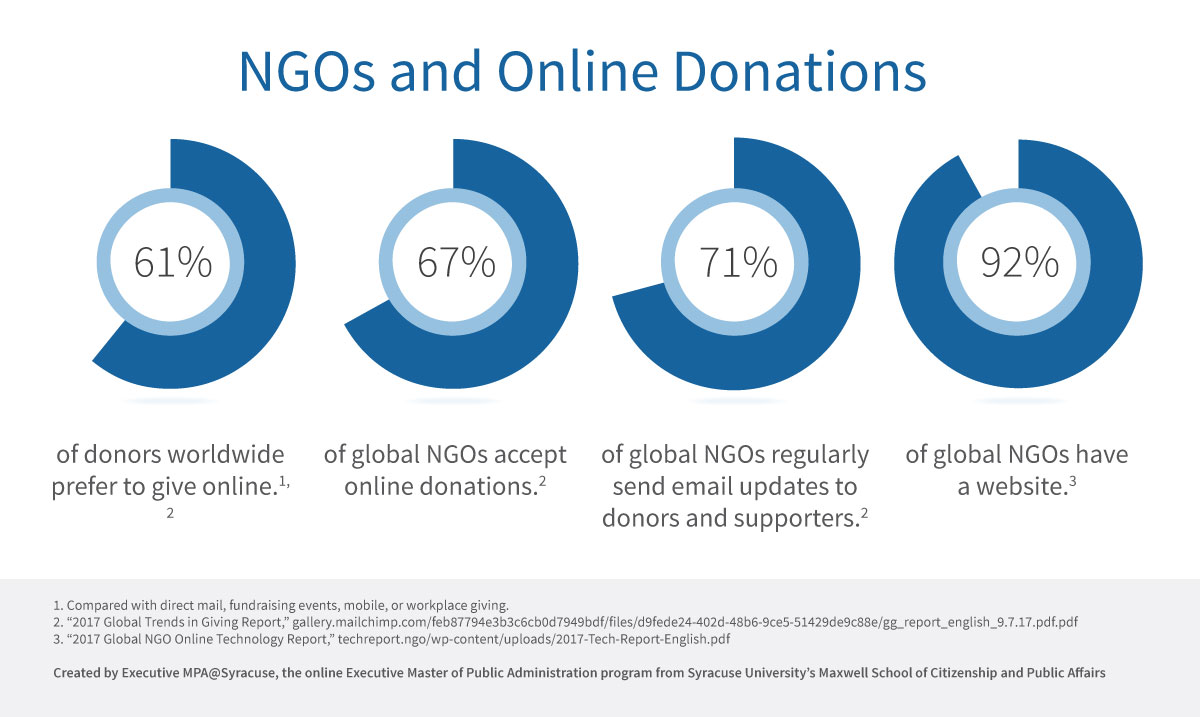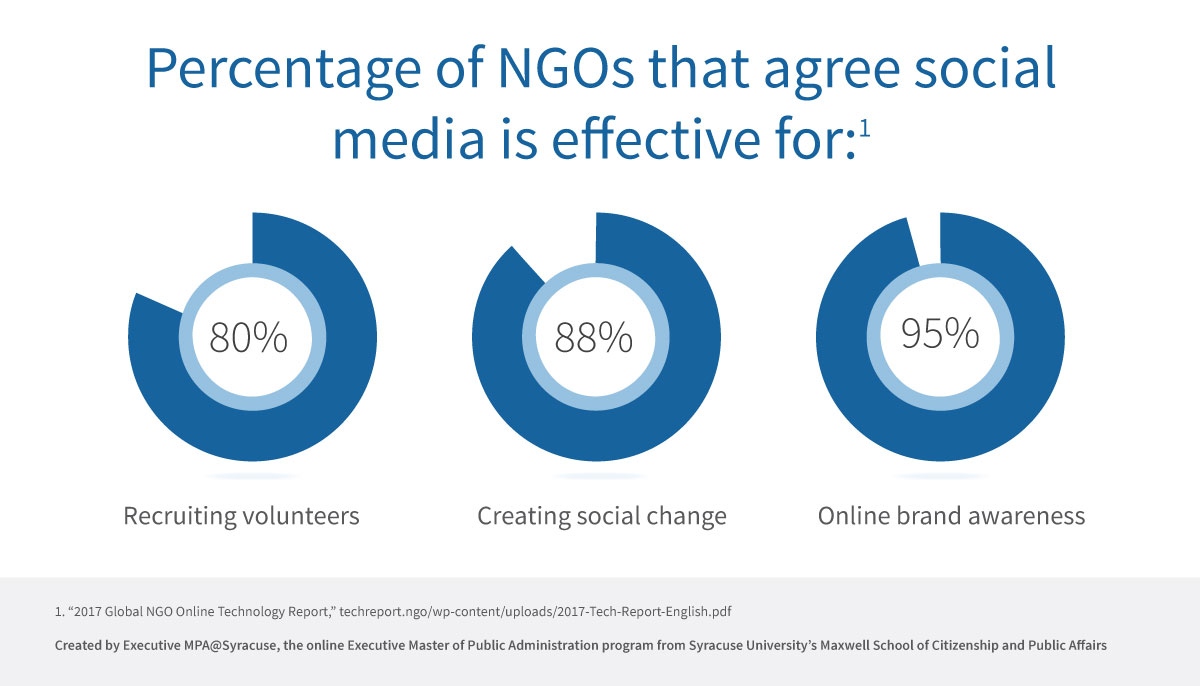Discussing Digitally Enabled NGOs with Tosca Bruno-van Vijfeijken

Today, the intergovernmental system is faced with the challenge of navigating an abundance of global economic, social and political issues—from conflict, climate change and poverty to the rapid-fire spread of ideas and markets—that extend beyond national borders. As director of the Transnational NGO Initiative, which focuses on how nongovernmental organizations (NGOs) can help with these challenges, Tosca Bruno-van Vijfeijken discusses the importance of community involvement and how transnational NGOs must integrate offline and online action to continue effecting global change, specifically in a digital world.
Q: First off, what is a transnational NGO (TNGO)?
A: Many NGO practitioners typically will use the word international NGO or INGO, that’s the most well-known term.
The word international refers to relationships between two nations, two nation-states or governments—”internation,” if you will. However, when we talk about cross-boundary relationships between multiple actors where one of them is a nonstate actor like an NGO, we prefer to call that “transnational.”
Q: You’ve been with the Transnational NGO Initiative for about 15 years. Can you describe the current work of the initiative and how it has evolved?
A: We focus on transnational or international NGOs that operate across at least one national border. We are particularly interested in the governance of such organizations, so how are transnational NGOs governed, how are they led, what is the effectiveness of their leadership, and how do they try to be effective.
We do both academic research as well as applied research. Sometimes that applied research is commissioned by NGOs, sometimes it is undertaken on our own initiative, but it is still applied in nature because we want to be relevant to the work of NGO practitioners.
Another way in which we exercise our mission, if you will, is by what we call “practitioner engagement.” By that we mean that the work is directly relevant for and focused on the sector. This work consists primarily of two topics: one is senior leadership development, how do you best develop high-quality senior leadership in the sector, and secondly, we help NGOs evaluate and assess the effectiveness of how they manage and lead change within the sector, so big organizational change processes.

NGOs and online donations: 61% of donors worldwide prefer to give online; 67% of global NGOs accept online donations; 71% of global NGOs regularly send email updates to donors and supporters; and 92% of global NGOs have a website.
Q: One of the main areas of research for the TNGO Initiative is digital NGO research. Could you describe what a digitally enabled NGO is and how NGOs are using digital platforms.
A: We all know that much of our world is dominated by the Internet these days and that most of our work is digitally enabled. That is more and more the case for NGOs as well.
So, if I look at digitally enabled NGOs in principle, I look at least at two kinds. I’m looking at the types of organizations such as GoFundMe, Kiva, GlobalGiving or other Internet-enabled platforms which enable direct citizen-to-citizen, peer-to-peer fundraising, for instance.
The other form, and that’s the one that we are most focused on in our own research, is on the campaigning side. So, for instance, there is a platform like Avaaz.org or Change.org where every citizen in the world can start their own petition. They allow citizens to campaign directly for the causes that these citizens care about by seeking petition support from other citizens. These petitions are then shared with politicians or government decision-makers.
Q: Do you see these digitally enabled NGOs as a meaningful tool of engagement or do you see the traditional NGOs still playing an important role?
A: I would say yes and yes. So, on the one hand the digital platforms are a real threat to traditional NGOs because a number of particularly younger citizens across the world, they don’t always want to be told by NGO staff, “Now you need to write a letter to the governor of province x to release this political prisoner,” or, “Now you need to show up for a demonstration.” They want to take action on their own terms. And traditional NGOs have, frankly, been late in coming to an understanding that this is a need of millennials, to take that action on their own terms.
Having said that, signing petitions typically will only have a limited impact. To give you an example, more and more politicians are sensing that the click of the button is very easy. But if an appeal for something or protest against something else does not come from people in their own districts, then politicians will not pay much attention to that, right? And at the same time if a petition leads a politician or a public servant to change their course of action in the way in which the citizen who started it intended it, that’s often only the beginning of a longer-term process of structural change that will be needed. Whether this is a change in regulation or policy, or long-term public education processes, or human rights awareness building among a population—just to offer some examples.
So, brick-and-mortar or legacy NGOs are saying that you still need long-term work happening in localities, long-term work that is based on expertise of NGO staff about certain topics. You also still need to build long-term relationships and trust within communities before certain forms of collective action can happen. And you still need to access high level decision-making forums to influence longer-term policy change work.
Q: Through your experience with the Transnational NGO Initiative, how would you recommend we marry these more established technical skill sets of traditional brick-and-mortar NGOs and their longstanding relationships with communities with the instant engagement of the digitally enabled platforms?
A: There are a number of brick-and-mortar or legacy NGOs that have more and more adopted digital strategies and tactics. So, if you look at Greenpeace it’s a really interesting example of a global NGO that has integrated mobilization with the understanding that a number of these especially younger citizens want to undertake action on their own terms rather than being told by NGOs what to do. So, they built digital platforms where people can sign up to initiate action, where they can come together in small “war rooms” to work together with other citizens who feel motivated to plan actions—actions that can be online or offline actions.

Percentage of NGOs that agree social media is effective for: recruiting volunteers (80%), creating social change (88%), online brand awareness (95%)
On the other hand, you’re now seeing, interestingly enough, that the fully digitally enabled platforms are finding that they have to marry their online action with offline action. So, they have to also capacitate their citizen supporters and members to take offline action by training them how to engage in a policy conversation with a decision-maker, for instance, or by how to write a persuasive letter to the media.
So, you see how the two sides are starting to both feel that they need to integrate some of the traditional strengths of the other side.
Q: Whose responsibility is it to make this change here? Is it that NGOs need to do a better job engaging individuals or is it individuals who need to bring more meaningful attention to their commitment to the work of these NGOs?
A: I think that NGOs of any kind would say normatively that citizens need to be more engaged because there are many things in this world that are wrong or could use improvement or need more support.
At the same time NGOs need to become better at understanding what triggers more engagement, and understanding that, especially for millennials and younger populations, they don’t want to just be told what to do. They want to be able to take action on their own terms.
It took some traditional NGOs a long time to understand that we’re not talking about improving or changing how they engage and communicate in a one-way direction with supporters, but that they have to move to two-way communication and direction where the supporters can also have more “agency” as academics like to call it, more ability to affect the types of actions that an NGO takes. I would argue that digitally enabled platforms understand that principle better, that the current-day citizen is expecting a two-way relationship with the NGO around a certain cause.
Q: What do you really hope the Transnational NGO Initiative can offer to NGOs as they’re trying to adapt to a more digitally minded audience?
A: So, one question is: Do digitally enabled platforms and NGOs manage to increase the depth of engagement of their supporters so people move up the ladder or “matrix of engagement,” as I’ve just explained? The other question is: Do digital platforms actually bring in a broader segment of the population in whatever country? So, do digital platforms manage to bring in more breadth of citizen engagement? That, we think, is a very interesting, worthwhile question as well, and it’s interesting to us that NGOs really don’t know that much about their supporters’ characteristics that way.
The final question we hope to bring to the table is, if you give your members and your citizens more agency, does it mean that we’re moving from an NGO staff-directed form of campaigning to a more citizen-led form of campaigning? That is actually, if you will, a greater cultural shift for a number of NGOs than they initially had realized.
This affects the very identity of NGO staff members and the motivations that brought them into the NGO sector. So, there’s very interesting research that can be done around the identity of NGO staff and why they are in it and what this has to do with ego, possibly, and with their self-understanding.
You still need staff, leadership, expertise and institutionalized organizations, but those same entities must also have a greater respect for and appreciation for the fact that citizens ultimately make up civil society, not only the officially registered NGOs.
That is what we call “citizen agency.” That’s what civil society ultimately is made of.
This interview has been edited for clarity.
Tosca Bruno–Van Vijfeijken is adjunct faculty at Syracuse University’s Maxwell School of Citizenship and Public Affairs. Her specialties include transnational civil society organizations including NGOs, program and organizational evaluation, and international development aid.
ExecutiveMPA@Syracuse, the Online Executive Master of Public Administration from Syracuse University’s Maxwell School of Citizenship and Public Affairs.


